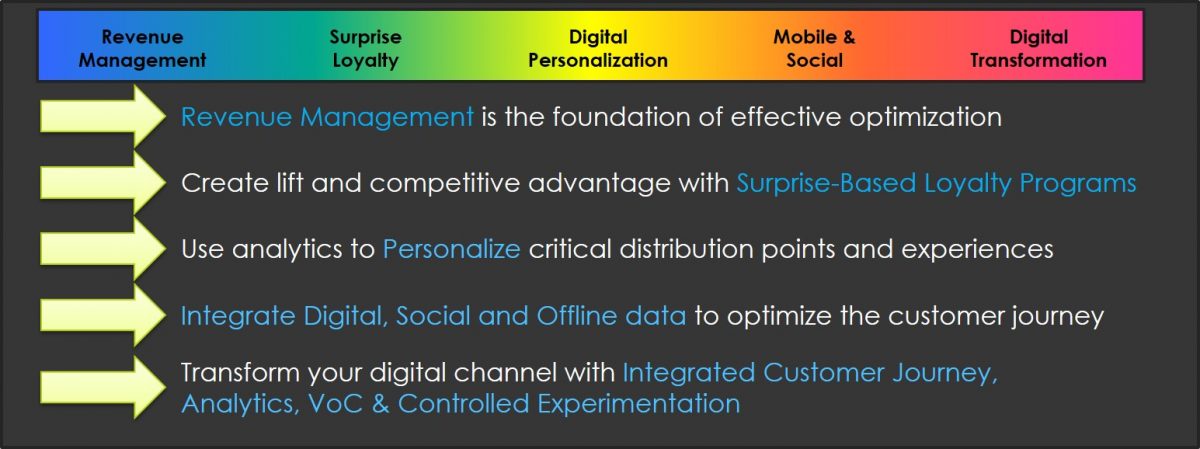Get your analytics BLISS on: Customer Journey Tracking in Hospitality
Get your analytics BLISS on: Customer Journey Tracking in Hospitality
By Gary Angel
|March 19, 2017

Ah to be at a resort. And not just for the sun, the swimming, the beaches and the drinking…it’s the measurement opportunities that really appeal. When it comes to physical journey measurement, resorts have it all. Large, complex physical spaces with an absolute premium on experience. Complicated staffing and numerous interactions. Overwhelmingly high opt-in rates for wifi. CRM uses out the wazoo. Resorts include a retail component, a dining component, a service component and whole bunch of physical spaces all with important experience optimization potential.
The opt-in component drives countless CRM opportunities – both in near real-time and for long-term follow-up and customer database enrichment. With on-property journey tracking you know how much time customers spend at the resort, how often they go out, where they like to spend their time and even what sort of pool they prefer. You can know whether a family likes to stick together or split up, when they like dine, and when and where they had to wait. All of this is incredibly useful stuff for personalization and messaging in EVERY channel.
Resorts are also a place where the intersection of CRM and navigation analytics can deliver deep insight into segmented experience optimization. For years, I’ve preached the simple and straightforward gospel that there isn’t a single best customer experience. There are countless different types of customers on countless journeys. Without bringing segmentation into your experience analysis, you’ll never be able to achieve true optimization across a population of any size.
And, of course, resorts are the ultimate example of clienteling. What retailers are trying to adopt, resorts and hospitality and have made core to their business.
Clienteling is a huge opportunity space for customer location tracking. But to understand why, a bit of digression into the background analytics is necessary. Years of work in digital have made me rather skeptical of real-time analytics. There was a time when digital analytics solutions were sold heavily on the basis of their real-time capabilities. Except in media, though, not many people found ways to take advantage of that capability. At the enterprise level, business decisioning doesn’t happen in real-time.
On the other hand, real-time does matter in personalization. It’s not that you can’t personalize without real-time analytics. You can (and should – it’s the right way to start). But there’s no doubt that what the customer is doing right now matters! A lot of companies that do in-store customer tracking see that as the real opportunity. Real-time couponing and messaging to customers as they move through your space. And there are plenty of solutions for delivering that.
But here’s the thing….it turns out that most people don’t want to be harassed as they walk around your store. And unlike resorts that have a lot of experiences guests might actually want to hear about, the sale in Aisle 6 probably doesn’t qualify. For a lot of folks, text messages are for friends and family. Not promotions. So we’ve seen consistently low opt-in rates for those systems – rendering them close-to or flat-out useless. And, of course, the lower the opt-in rates the worse the lift performance. You end up subsidizing that tiny population of coupon clippers who drive you crazy in every channel.
Which is the the long way around to why at Digital Mortar, not only have we chosen to focus on measurement not messaging, it’s why we believe that the best use of real-time analytics in both hospitality and retail isn’t to drive customer SMS – it’s to support staff with clienteling. You don’t have opt-out issues with Associates and staff. What you have is the ability to use analytics to drive better conversations in the RIGHT NOW – using what you know about customer including what you’ve just learned in the last 10 minutes.
Key Questions
- How do new visitors get to “know” the resort and what parts of the experience stick?
- What experiences tend to group together and are their flow issues or bottlenecks that damage the experience?
- Are there under-served experience areas from a staffing perspective?
- What data is most valuable from a CRM perspective?
- What real-time data can drive better real-time conversations at every touchpoint?